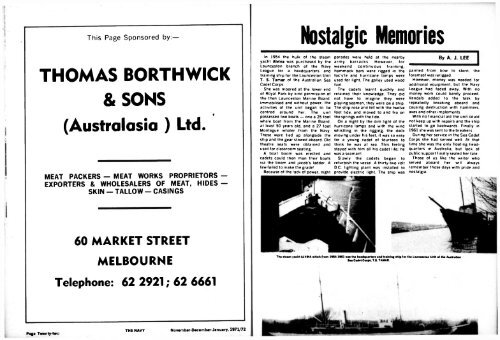Aug-Sep-Oct, Nov-Dec 1971-Jan 1972 - Navy League of Australia
Aug-Sep-Oct, Nov-Dec 1971-Jan 1972 - Navy League of Australia
Aug-Sep-Oct, Nov-Dec 1971-Jan 1972 - Navy League of Australia
- No tags were found...
Create successful ePaper yourself
Turn your PDF publications into a flip-book with our unique Google optimized e-Paper software.
This Page Sponsored by:—THOMAS BORTHWICK& SONS«(Australasia ) Ltd.MEAT PACKERS — MEAT WORKS PROPRIETORS —EXPORTERS & WHOLESALERS OF MEAT, HIDES —SKIN — TALLOW — CASINGSIn 1954 the hulk <strong>of</strong> the steamyacht Alvina was purchased by theLaunceston branch <strong>of</strong> the <strong>Navy</strong><strong>League</strong> for a headquarters andtraining ship for the Launceston UnitT. S. Tamar <strong>of</strong> the <strong>Australia</strong>n SeaCadet Corps.She was moored at the lower end<strong>of</strong> Royal Park by kind permission <strong>of</strong>the then Launceston Marine Board.Immobilised and without power, theactivities <strong>of</strong> the unit began to becentred around her. The unitpossessed two boats — one a 25 footwhale boat from the Marine Board,at least 50 years old. and a 27 footMontague whaler from the <strong>Navy</strong>.These were tied up alongside theship and the gear stowed aboard. Oldtheatre seats were obtained andused for classroom seating.A boat boom was erected andcadets could then man their boatsvia the boom and jacob's ladder. Afew failed to make the grade!Because <strong>of</strong> the 'ack <strong>of</strong> power, nightNostalgic Memoriesparades were held at the nearbyarmy barracks. However, forweekend continuous training,hammock bars were rigged in thefoc's'le and hurricane lamps wereused for light. The galley used woodfuel.The cadets learnt quickly andretained their knowledge. They didnot have to imagine they wereplaying seamen, they were on a ship.The ship rose and fell with the twelvefoot tide, and moved to and fro onthe springs with the tide.On a night by the dim light <strong>of</strong> thehurricane lamps and with the windwhistling in the rigging, the deckmoving under his feet, it was so easyfor a young cadet <strong>of</strong> fourteen tothink he was at sea. This feelingstayed with him all his cadet life; hewas a seaman!Slowly the cadets began torefurbish the vessel. A thirty-two voltDC. lighting plant was installed toprovide electric light. The ship wasBy A. J. LEEpainted from bow to stern, theforemast was rerigged.However, money was needed foradditional equipment, but the <strong>Navy</strong><strong>League</strong> had faded away. With nomoney work could barely proceed.Vandals added to the task byrepeatedly breaking aboard andcausing destruction with hammers,axes and other implements.With no financial aid the unit couldnot keep up with repairs and the shipstarted to go backwards. Finally in1961 she was sent to the breakers.During her service in the Sea CadetCorps she had served well. At thattime she was the only floating headquartersin <strong>Australia</strong>, but lack <strong>of</strong>public support finally sealed her fate.Those <strong>of</strong> us like the writer whoserved aboard her will alwaysremember those days with pride andnostalgia.60 MARKET STREETMELBOURNETelephone: 62 2921; 62 6661The (team yacht ALVINA which from 1954-1961 was tha headquarters and training ship for the Launceston Unit <strong>of</strong> the <strong>Australia</strong>nSea Cadet Corps. T.S. TAMAR.Pag* Twenty-twoTHE NAVY <strong>Nov</strong>embar-Dacembar-<strong>Jan</strong>uary, <strong>1971</strong>/72
















